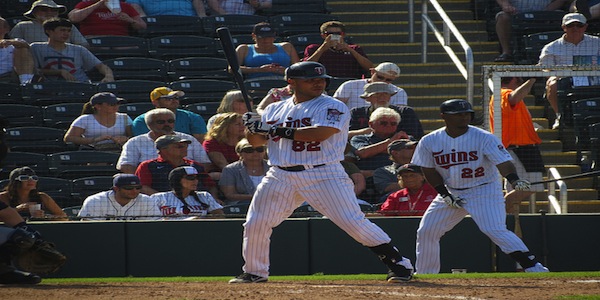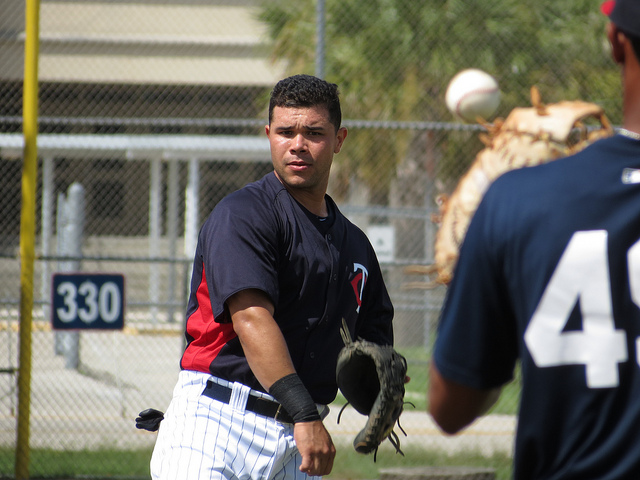45 Prospects in 45 Days: Minnesota’s Josmil Pinto


Over the next 45 days the staff here at the Fix will profile and predict the fantasy fates of prospects that could – should, in some cases – be closely monitored on the waiver wire or even in the draft room.
For the projection portion of the article, we will try our best to give you projections from all three major projection systems. Those projection systems are: ZiPS, Steamer, and Oliver. Oliver varies from the other two by projecting what a player would accomplish over 600 PA. Obviously, most prospects won’t reach 600 PA, due to various reasons. It can help to pay more attention to the rate stats that are included in order to get a clearer idea of what you’re dealing with in a particular player.
Profile
The Minnesota Twins boast one of the top farm systems in all of Major League Baseball and Josmil Pinto is just one of the many rising prospects within the organization. Pinto is 5’11 and weighs 210 pounds, a prototypical catcher build. The native Venezuelan was signed by the Twins as a 16-year-old back in 2006 but didn’t start playing full-season ball in the states until 2010. Pinto was added to the Twins 40-man roster after the 2012 season in order to protect him from the Rule 5 draft. After being called up from the Rochester Red Wings, the Twins’ Triple-A affiliate late last season, the 24-year-old catcher performed quite well in his limited stint with the big league club. In 21 MLB games, Pinto posted a sizzling .342/.398/.566 slash line with four home runs and 12 RBIs in his 83 plate appearances.
Pundits
For this section ESPN’s Keith Law and Jason Parks of Baseball Prospectus will be the primary prospect sources. Since MLB.com didn’t include Pinto in their top 100 prospects and Baseball America didn’t list Pinto as a top 10 prospect for the Twins, I left them out.
Law excluded Pinto from his top 100 prospect rankings but he did rank Pinto as the eighth best prospect for the Twins and the 18th ranked impact prospect for the 2014 MLB season. Law says one thing that may hold Pinto back is his shoddy defense and although defense doesn’t matter for fantasy purposes, it can definitely negatively impact potential playing time. Law likes Pinto’s offensive ability though and thinks that is a primary reason why he will receive ample playing time:
Pinto is probably the heir apparent to Joe Mauer in Minnesota. His bat is ready to play, but his glove isn’t, and he’ll likely always be an offense-first catcher. The Twins will face a tough decision this year on how to work Pinto into the major league lineup; he needs to catch every day to improve his receiving — and he’d probably be better off doing that in Triple-A — but he’s also their best candidate to give them some offense behind the plate.
In his top 101 prospect list for Baseball Prospectus, Parks ranked Josmil Pinto as the 56th best prospect in MLB. Additionally, Parks ranked Pinto as the fifth best prospect within the Twins organization.
These prospect gurus seem to think highly of the offensive potential Pinto possesses but unless he can improve his skills behind the plate, he might not be able to bring his infusion of offense to the Twins on a daily basis.
Minor League Production
|
Year |
Level | Games |
PA |
HR |
R |
RBI |
BB% |
K% |
ISO |
BABIP |
AVG |
OBP |
SLG |
| 2008 |
Rookie |
24 |
94 |
1 |
14 |
14 |
9.6% |
14.9% |
.212 |
.386 |
.329 |
.394 |
.541 |
| 2009 | Rookie |
53 |
230 |
13 |
34 |
55 |
8.3% |
17.0% |
.278 |
.350 |
.332 |
.387 |
.610 |
| 2010 |
A |
100 |
392 |
10 |
60 |
54 |
8.2% |
17.1% |
.153 |
.246 |
.225 |
.295 |
.378 |
| 2011 |
A |
9 |
36 |
1 |
4 |
9 |
5.6% |
27.8% |
.188 |
.304 |
.250 |
.278 |
.438 |
| 2011 |
A+ |
64 |
236 |
5 |
21 |
32 |
5.1% |
15.3% |
.127 |
.293 |
.262 |
.305 |
.389 |
| 2012 |
A+ |
93 |
393 |
12 |
45 |
51 |
9.9% |
16% |
.178 |
.326 |
.295 |
.361 |
.473 |
| 2012 |
AA |
12 |
52 |
2 |
8 |
9 |
7.7% |
19.2% |
.255 |
.343 |
.298 |
.365 |
.553 |
| 2013 |
AA |
107 |
453 |
14 |
59 |
68 |
14.1% |
15.7% |
.174 |
.349 |
.308 |
.411 |
.482 |
| 2013 |
AAA |
19 |
75 |
1 |
6 |
6 |
2.7% |
26.5% |
.171 |
.356 |
.314 |
.333 |
.486 |
Pinto has had four years of seasoning in the minor leagues (excluding his two rookie ball seasons) and has generally performed well down in the Twins farm system. After adding up all the numbers and getting the averages for each category, there were a few specific statistics that Pinto excelled at. Across his four minor league seasons, Pinto put up a .272 batting average, .330 on-base percentage, and .447 slugging percentage. According to ESPN, the 2013 MLB average for batting average was .253, .317 OBP, and .396 SLG. As you can see, Pinto bests all the MLB averages in the aforementioned categories and has shown the propensity to hit for a high average while also displaying impressive power numbers.
According to FanGraphs, Isolated power (ISO) is a way to measure a hitter’s raw power and Pinto put up a .174 ISO during his minor league career, which is very close to being above average according to their chart. Furthermore, Pinto’s 7.7 BB% and 18 K% are roughly league average numbers. Pinto had his most impressive season yet across Double-A New Britain and Triple-A Rochester in 2013 as he posted career-highs in average (.309), home runs (15), RBIs (74), and walks (66), while also belting 48 extra-base hits in 126 games.
Although some of the sample sizes were small due to being promoted to higher levels or injuries (shoulder), Pinto has displayed encouraging power and batting average numbers. While it’s no guarantee that Pinto will be able to sustain his offensive output in MLB since he will be facing superior competition, his ability to find holes on a consistent basis (.307 BABIP) while also showing power, bodes well for his chances to be a quality hitter at the major league level. A side note on Pinto is that he had a contact rate of 76.3% during his Twins stint in 2013 compared to the MLB average of 79.5% so while his rate is a little below average he’s certainly no Adam Dunn when it comes to putting the ball in play.
Projections
|
System |
PA |
R |
HR |
RBI |
BB% |
K% |
AVG |
OBP |
SLG |
|
Steamer |
339 |
37 |
9 |
37 |
7.8% |
17.8% |
.257 |
.319 |
.404 |
|
Oliver |
600 |
66 |
16 |
71 |
7.7% |
23.3% |
.256 |
.317 |
.405 |
|
ZiPS |
563 |
64 |
14 |
59 |
7.6% |
21.7% |
.255 |
.314 |
.395 |
The projection systems vary on how many plate appearances they believe Pinto will receive in 2014. It’s interesting to note the 224 PA difference projection between Steamer and ZiPS and that could be a result of Kurt Suzuki garnering most of the playing time. With the projected differences in playing time, it makes sense as to why Pinto’s counting stats like home runs, RBI, and runs all over the board.
One statistic where all three systems seem to agree on is Pinto’s power and double-digit home runs seems likely even though he’ll be playing in the cavernous Target Field. Although the systems don’t project Pinto to be anything more than average in any category other than home runs, they don’t necessarily project him to be very bad in any category either.
Prediction
Before the offseason began it looked as if Pinto would be the surefire option to replace Mauer at catcher since he is moving to first base on a full-time basis. But after the Twins signed a seasoned veteran in Suzuki to be the placeholder at catcher until Pinto is ready for the everyday job, the outlook on Pinto’s sophomore campaign in 2014 has become predictably hazy. Since Suzuki is destined to be the starting catcher for the Twins this year, Pinto can only be considered a fantasy option for leagues where you start two catchers and even in that circumstance Pinto would be a shaky second catcher at best due to lack of playing time. There is also an outside chance Pinto starts the year in the minor leagues.
The main reason why Suzuki seems to have been anointed the starting job is for Pinto’s questionable defense. What makes this decision all the more confusing is Suzuki isn’t exactly a defensive stalwart himself and Pinto has been described as having an above average arm. Noted Twins expert Aaron Gleeman sums up the situation best when he says:
Pinto may prove incapable of being a decent defensive catcher, but his offensive upside is sizable and at age 25 there’s a chance that he could develop into a good all-around catcher. Meanwhile, in the past three seasons Suzuki hit .235/.290/.353 while throwing out just 25 percent of stolen base attempts and rating very poorly in pitch-framing analysis. Suzuki hasn’t been a starting-caliber catcher since 2009 and the Twins are likely to be mediocre at best, so why not let Pinto play?
With all of this being said, you’re unlikely to reap the benefits of Pinto’s 2014 season unless you are in a deep re-draft or keeper league as evidenced by his 313 ADP according to NESN. I tend to think that Pinto’s production this season will more closely resemble the Steamer projections rather than the ZiPS or Oliver projections since it looks like Pinto will begin the year as a part-time player at catcher unless the Twins decide to they need to have his bat in the lineup and throw him in at DH sometimes. In re-draft two-catcher leagues Pinto should either not be picked at all or if you’re feeling lucky use a pick on him in the last few rounds since he has some upside and could become the everyday catcher down the stretch.
Now the moment you’ve all been waiting for, my prediction for Pinto in the upcoming year. I see Pinto hitting for a .268 average with 46 runs, 11 home runs, 51 RBIs, and a .330 OBP.
Thanks to ESPN, FanGraphs, Baseball-Reference, and NESN for the statistical information. You can follow me on Twitter @MattMoczy and feel free to send me any fantasy related questions you may have.






